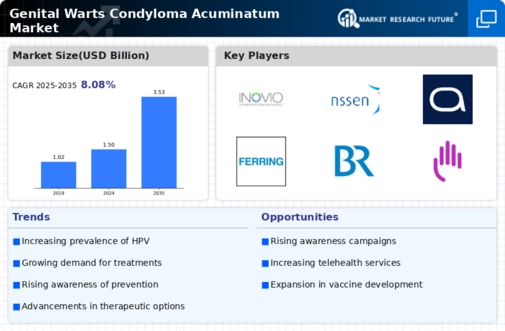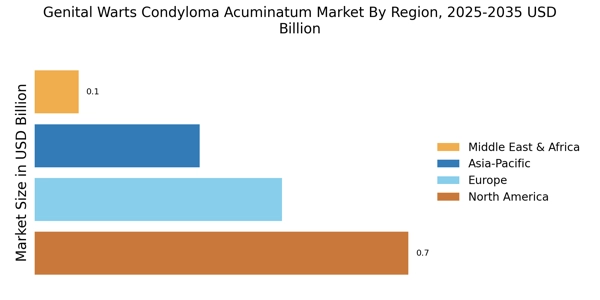Increased Awareness and Education
The Genital Warts Condyloma Acuminatum Market is experiencing a notable shift due to heightened awareness and education regarding sexually transmitted infections. Public health campaigns and educational initiatives have been instrumental in disseminating information about the causes, symptoms, and treatment options for genital warts. This increased awareness is likely to lead to higher rates of diagnosis and treatment-seeking behavior among affected individuals. As a result, the demand for therapeutic interventions is expected to rise, thereby propelling market growth. Furthermore, educational programs targeting healthcare providers are enhancing the quality of care, which may contribute to improved patient outcomes. The overall impact of these awareness efforts is anticipated to foster a more informed patient population, ultimately driving the Genital Warts Condyloma Acuminatum Market forward.
Regulatory Support and Guidelines
Regulatory support and the establishment of clinical guidelines are pivotal in shaping the Genital Warts Condyloma Acuminatum Market. Health authorities are increasingly recognizing the importance of addressing sexually transmitted infections, leading to the development of comprehensive guidelines for the prevention, diagnosis, and treatment of genital warts. These guidelines not only standardize care but also encourage healthcare providers to adopt evidence-based practices. Furthermore, regulatory bodies are facilitating the approval of new treatment options, thereby expanding the therapeutic arsenal available to clinicians. This supportive regulatory environment is likely to enhance patient access to effective treatments, ultimately driving growth in the Genital Warts Condyloma Acuminatum Market.
Technological Advancements in Treatment
Technological advancements in treatment modalities are significantly influencing the Genital Warts Condyloma Acuminatum Market. Innovations such as laser therapy, cryotherapy, and immunotherapy are becoming increasingly prevalent, offering patients more effective and less invasive options for managing genital warts. These advancements not only improve treatment efficacy but also enhance patient comfort and satisfaction. The introduction of new therapeutic agents and delivery systems is likely to expand the treatment landscape, catering to diverse patient needs. Moreover, the integration of telemedicine in treatment protocols is facilitating access to care, particularly in underserved regions. As these technologies continue to evolve, they are expected to play a crucial role in shaping the future of the Genital Warts Condyloma Acuminatum Market.
Growing Investment in Research and Development
Growing investment in research and development is emerging as a significant driver for the Genital Warts Condyloma Acuminatum Market. Pharmaceutical companies and research institutions are increasingly allocating resources to explore novel therapeutic approaches and improve existing treatment modalities. This focus on R&D is expected to yield innovative solutions that address the unmet needs of patients suffering from genital warts. Additionally, collaborations between academia and industry are fostering the development of cutting-edge therapies, which may enhance treatment outcomes. As the pipeline for new interventions expands, the potential for market growth becomes more pronounced. The commitment to advancing research in this area is likely to play a crucial role in shaping the future landscape of the Genital Warts Condyloma Acuminatum Market.
Rising Prevalence and Demand for Interventions
The rising prevalence of genital warts is a critical driver for the Genital Warts Condyloma Acuminatum Market. Epidemiological studies indicate that a significant portion of the sexually active population is affected by human papillomavirus (HPV), the primary cause of genital warts. This increasing incidence is likely to escalate the demand for effective interventions, including vaccines and therapeutic treatments. The availability of HPV vaccines has shown promise in reducing the incidence of genital warts, yet the need for treatment remains substantial. Consequently, healthcare providers are focusing on early detection and management strategies, which may further stimulate market growth. The interplay between rising prevalence and the demand for interventions is expected to create a robust environment for the Genital Warts Condyloma Acuminatum Market.


















Leave a Comment